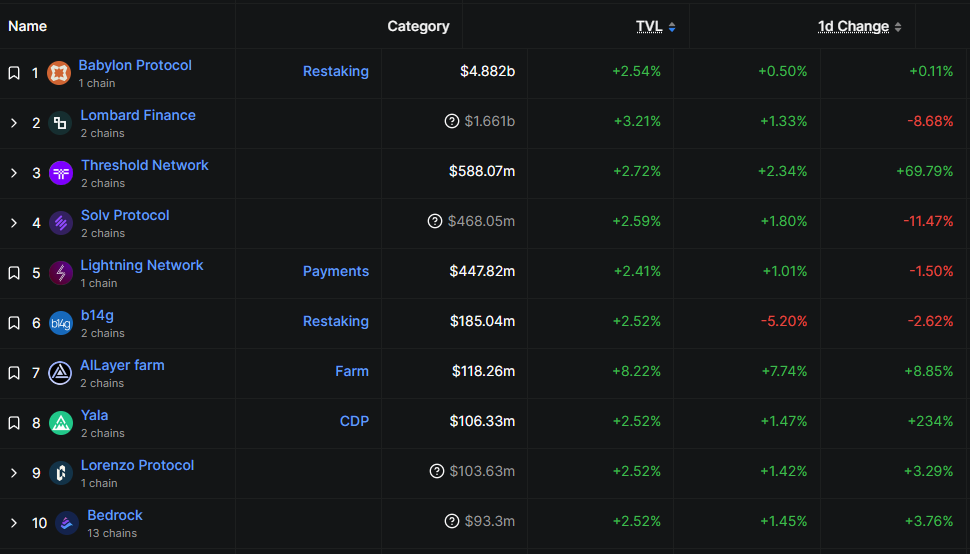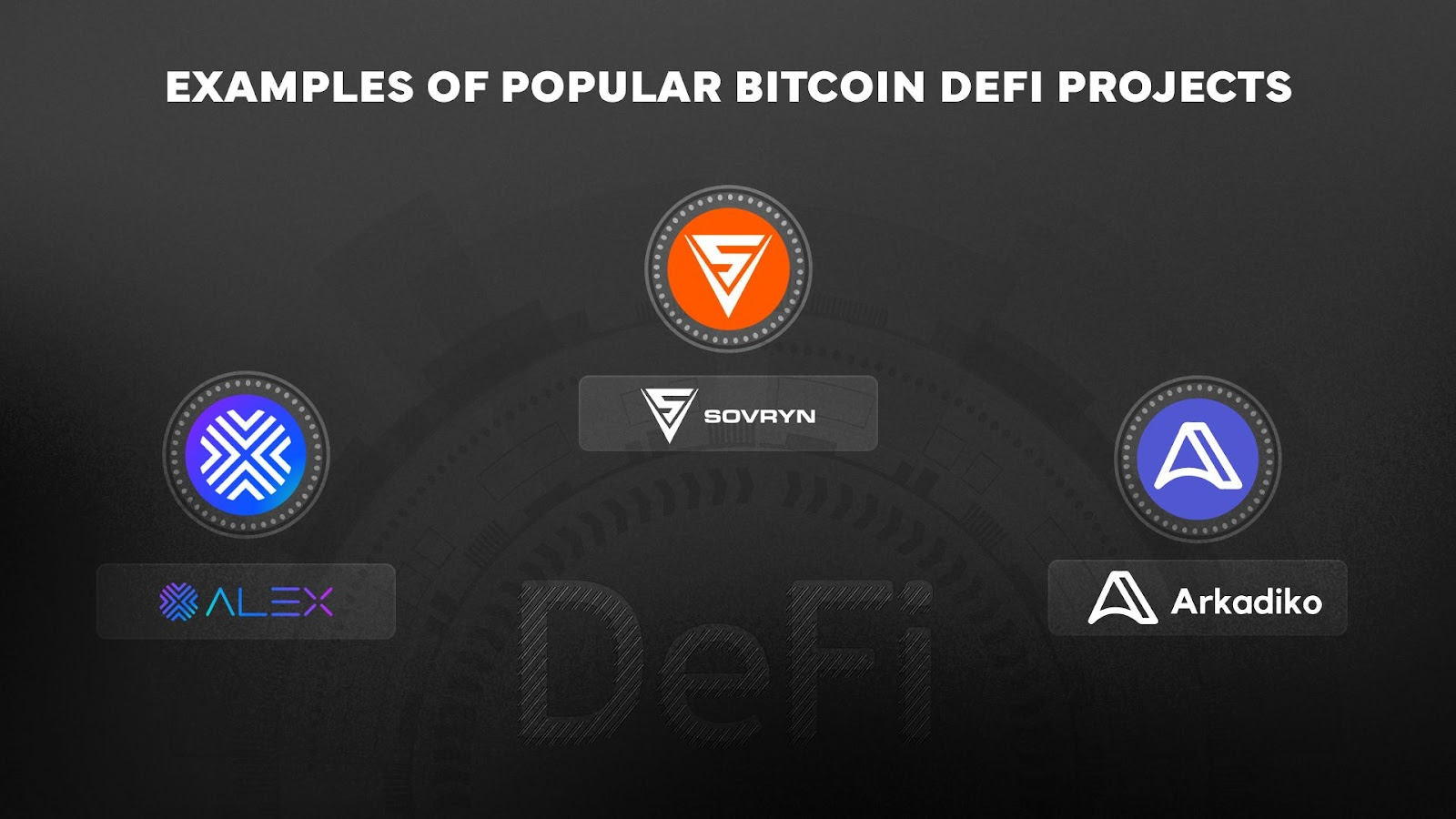Bitcoin
Bitcoin CPI
Venture Portfolio
Funds
Market Insights
Indicators
About
Contact

September 6, 2025





Bitcoin DeFi has been growing steadily in recent years, creating Internet-native financial products and services powered by the most secure blockchain in the world.
Hosted on both the Bitcoin mainnet and on Layer 2, there’s a growing number of Bitcoin-centric DeFi apps that allow BTC “HODLers” to put their digital gold to work.
Read on to learn everything you need to know about Bitcoin DeFi and the opportunities this new market offers.
Decentralized Finance, or DeFi in short, is a broad term for financial services accessible on public blockchains.
DeFi allows users to lend, borrow, earn interest, trade derivatives, and more. These financial products and services are similar to what you typically find in traditional finance (TradFi).
However, unlike TradFi, which is run by centralized institutions like banks, DeFi is run by smart contracts on-chain. There are no intermediaries. Users transact peer-to-peer, giving them more control over their assets while allowing them to pay less fees.
To access DeFi products, users engage with decentralized apps (dApps) via a self-custody crypto wallet. Generally, DeFi applications don't have KYC requirements, and this opens up financial services to anyone with an Internet connection and a digital wallet.
Bitcoin DeFi refers to decentralized financial applications and products built on the Bitcoin blockchain or Bitcoin layers.
Due to the limited smart contract abilities on the Bitcoin blockchain, most Bitcoin DeFi activities occur on Bitcoin layers. Bitcoin Layer-2 protocols support Bitcoin smart contracts suitable for establishing a large Bitcoin-secured DeFi ecosystem.
That said, new innovations like the proposed Bitcoin Virtual Machine (BitVM) could bring advanced smart contracts to Bitcoin Layer 1, allowing developers to create DeFi applications on-chain.
Moreover, the emergence of the Ordinals protocol has introduced the DeFi use case of asset issuance directly on Bitcoin in the form of BRC-20 tokens.
The total value locked (TVL) in Bitcoin DeFi stands at over $6 billion. In comparison, Ethereum's TVL is 10x higher at over $60 billion. However, Bitcoin DeFi has achieved significant growth in the last few years.

The evolution of decentralized finance (DeFi) on Bitcoin has been marked by various phases and attempts to extend Bitcoin's functionality beyond peer-to-peer payments.
Early efforts began with the concept of colored coins in 2012-2013. These coins allowed users to add metadata to Bitcoin transactions, creating tokens that could represent real-world assets like stocks or real estate. Although promising, this approach faced scalability challenges and limited use cases.
As colored coins struggled to achieve widespread adoption, the focus shifted to sidechains like Blockstream's Liquid Network, launched in 2018. Liquid allowed for faster transactions and asset creation, but its federated nature limited its decentralization, making it less appealing to many users.
Around the same time, the Lightning Network emerged, offering a different approach to scaling. Proposed in 2015 and launched in 2018, it enabled near-instant, low-cost transactions through off-chain payment channels. Its primary focus was payments, so it didn't initially support a broad range of DeFi applications.
Taproot, activated in 2021, marked a key advancement in Bitcoin's ability to handle complex transactions. It improved privacy and scalability, making it easier to develop DeFi applications directly on Bitcoin without compromising its core principles.
Today, newer Layer 1 and Layer 2 solutions like Ordinals and Stacks are driving further innovation. Ordinals, which gained traction beginning in 2023, enables the creation of NFTs and tokenized assets on the Bitcoin main chain. Meanwhile, Stacks, launched in 2021, uses a Proof-of-Transfer mechanism to add smart contracts to the Bitcoin ecosystem.
These developments have gradually turned Bitcoin from a simple transaction network into a platform capable of supporting elaborate DeFi.
The challenge remains balancing Bitcoin’s core values of security and decentralization with the demand for new functionalities. Yet, the progress shows growing potential for Bitcoin's role in the DeFi space.
DeFi on Bitcoin leverages smart contracts to process transactions on decentralized applications. These self-executing, autonomous lines of code act to replace intermediaries, enabling dApp users to transact peer-to-peer.
Each Bitcoin layer that supports DeFi uses a different smart contract language to power its dApps. For example, the Stacks network is built with Clarity, while Rootstock (RSK) smart contracts are Solidity-based, allowing developers to deploy them on Ethereum as well.
On the contrary, projects enabling native Bitcoin DeFi do so on a very small scale since they work with the protocol as it is rather than altering the code. They leverage existing features like Unspent Transaction Outputs (UTXOs) to append the data necessary to create fungible or non-fungible tokens.
Having said that, all DeFi transactions settle on the Bitcoin blockchain, whether the product is enabled natively or on a secondary protocol.

Now, let’s take a look at some of the existing and potential future Bitcoin DeFi use cases.
The Lightning Network (LN), a Layer 2 network built on Bitcoin, is the largest enabler of Bitcoin DeFi payments. It offers near-instant, high-volume, and cheap transactions between parties.
According to DeFi Llama, payments and restaked BTC are the leading contributors to Bitcoin DeFi Total Value Locked (TVL). Babylon Protocol, a platform that supports restaking of bitcoin, leads with a TVL of close to $5 billion. Lombard Finance ranks second with a TVL of close to $1.5 billion.

DEXs are peer-to-peer platforms where users can swap tokens directly from their wallets. These exchanges are built on the Bitcoin layers, such as Stacks and Rootstock. Some popular Bitcoin DEXs are ALEX, Velar, and Sovryn.
Bitcoin stablecoins are backed by stable fiat currencies like the dollar. They allow holders to safeguard the value of their crypto asset holdings from high volatility. Moreover, users can mint stablecoins on lending and borrowing protocols by locking up a digital asset as collateral.
RSK has several stablecoins like Dollar on Chain (DOC), XUSD, and BRZ. Additionally, Stacks has a stablecoin known as USDA.
Bitcoin atomic swaps permit users to swap tokens peer-to-peer between the base layer and the Layer 2 protocol. This means users can seamlessly move assets between the two layers whenever they want or need. Stacks-based LNSwap is a DeFi protocol that leverages atomic swaps, enabling users to swap Bitcoin on-chain and on Lightning with Stacks tokens.
Borrowers can secure loans without going through an intermediary on Bitcoin-secured lending and borrowing protocols such as Liquidium. On the other hand, lenders earn interest for lending their crypto assets to borrowers.
Both fungible and non-fungible tokens are being issued directly on Bitcoin and Layer 2 protocols like Stacks, Liquid, and RSK. Fungible tokens include stablecoins, wrapped versions of Bitcoin, as well as security tokens.
Native Bitcoin NFTs are made possible by Ordinals. Furthermore, BRC-20 and ORC-20 token standards allow users to mint fungible tokens directly on Bitcoin.
DAOs are community-led groups established to decentralize the decision-making process of DeFi protocols. Community members who own the governance token of the protocol are allowed to vote on all development proposals.
DAOs have been built on RSK and Stacks by various DeFi protocols like Sovryn, Lydian, and Money On Chain.
Prediction markets on Bitcoin - powered by a type of Bitcoin smart contract known as a Discreet Log Contract (DLC) - could enable users to bet on real-world or blockchain-based outcomes.
A DLC is a multisig transaction that uses oracles to execute predefined conditions of a smart contract.

Building decentralized finance (DeFi) on Bitcoin is gaining traction thanks to several of the leading blockchain’s key strengths.
Bitcoin is one of the most decentralized blockchain networks due to its proof-of-work (PoW) system. A global network of miners verifies transactions, making it nearly impossible for any single entity to take control.
Unlike proof-of-stake systems, where power can be concentrated in a few hands, Bitcoin’s PoW distributes influence more evenly. This approach aligns with DeFi’s emphasis on transparency and fairness.
The Bitcoin network has unmatched security, built on its vast computational power or hashrate. The network is very resistant to attacks, as attackers would need to gain control of 51% of the network’s mining power.
Such an attack is practically unfeasible due to Bitcoin’s widespread mining operations. This strong foundation makes the network a solid choice for DeFi projects that need a high degree of trust and reliability.
Bitcoin’s track record of uptime and consistency speaks for itself. Since 2009, it has had only a couple of brief interruptions, making it a reliable choice for financial services that need to be available at all times.
DeFi platforms on Bitcoin can depend on this steady performance, providing users a smooth and predictable experience.
Bitcoin’s prominence and liquidity make it central to the crypto market. It’s the most recognized cryptocurrency, with a large user base and deep trading volumes, allowing easy conversion to fiat currencies. This liquidity is crucial for DeFi, as it supports large transactions without causing significant market shifts.
Additionally, Bitcoin’s established reputation draws in institutional investors and players from traditional finance, expanding its role in the DeFi space.
The wave of new Layer 2 solutions, including the likes of Rootstock, Stacks, Build on Bitcoin (BoB), Ark, Mezo, and more, have expanded Bitcoin’s capabilities.
These innovations support more complex smart contracts and decentralized applications (dApps) on Bitcoin. They allow transactions to be faster and less costly, which helps Bitcoin scale while keeping its security and decentralization intact.
Bitcoin’s design naturally fits DeFi's goals, such as reducing reliance on intermediaries and increasing financial access. DeFi projects can build on Bitcoin’s infrastructure to offer services like lending, borrowing, and decentralized exchanges that operate transparently.
This aligns with the vision of an open financial system that resists censorship and centralized control.
All these qualities make Bitcoin a powerful contender for the DeFi movement. As the Bitcoin-based DeFi ecosystem grows, it’s poised to draw more users and developers, harnessing its unique strengths to build a secure, efficient, and truly decentralized financial future.

Now, let’s take a look at examples of popular protocols in the Bitcoin DeFi ecosystem.
ALEX is a decentralized exchange (DEX) built on the Stacks blockchain, offering a suite of DeFi services. Users can swap tokens, engage in liquidity provision through yield farming, and stake their assets to earn rewards.
The platform supports trading BRC-20 tokens, expanding its ecosystem to accommodate tokens issued on the Bitcoin network through integrations with the broader Bitcoin-DeFi space.
ALEX has also continued to develop its governance model, allowing users to participate in decision-making processes by staking ALEX tokens and engaging in the governance process.
Arkadiko is a DeFi lending and trading protocol on the Stacks network, offering unique opportunities to utilize Bitcoin in a decentralized finance context. It allows users to obtain loans backed by digital assets, including a representation of Bitcoin (xBTC) on the Stacks network.
The protocol also supports token swaps and the minting of USDA, a Stacks-based stablecoin pegged to the US dollar. Users can lock up assets like STX (Stacks' native token), xBTC (a representation of Bitcoin on Stacks), or the governance tokens from the ALEX protocol as collateral to mint USDA.
Arkadiko has expanded its focus on increasing accessibility and usability, aiming to enhance liquidity for its stablecoin while promoting broader adoption in the Stacks ecosystem.
Sovryn is a decentralized finance (DeFi) protocol built on RSK and BoB, offering users a range of trading, lending, and borrowing options. The protocol allows for the decentralized trading of Bitcoin and other assets, along with the ability to earn through staking in liquidity pools or by participating in stability pools to support the platform’s ecosystem.
Sovryn also features its own stablecoin, the Sovryn Dollar (DLLR), a dollar-pegged asset designed to provide stability and expand financial services within the Sovryn ecosystem.
The protocol continues to expand its integrations and focuses on providing secure, Bitcoin-native financial services, including Bitcoin-backed lending and margin trading. Sovryn aims to bridge the gap between Bitcoin and DeFi, offering a user experience that maintains a close connection to the Bitcoin blockchain.
A growing Bitcoin DeFi market will expand Bitcoin’s utility, potentially enabling it to compete with Turing-complete smart contract blockchains such as Ethereum, which has dominated the DeFi market for years.
Going forward, it will be exciting to see how Bitcoin transforms from a DeFi perspective as developers continue innovating and building the ecosystem.
No. Bitcoin is a Layer 1 blockchain. Builders develop DeFi applications either directly on top of Bitcoin or on Layer 2 protocols running parallel to the Bitcoin network. Most applications are built on the Layer 2 side of things. All DeFi transactions within the Bitcoin ecosystem eventually settle on the base layer.
Bitcoin layers enabling DeFi include RSK, Stacks, Liquid, and Lightning. Newish Layer 2 protocols like RGB, Taproot Assets, and MintLayer will also contribute to Bitcoin DeFi in the future.
Bitcoin DeFi carries risks similar to those in the broader DeFi ecosystem. Smart contract vulnerabilities, platform security issues, and interoperability risks can lead to the loss of funds.
To mitigate these risks, it's crucial to use reputable platforms that have undergone security audits and to stay informed about the latest developments.
Bitcoin is a Layer 1 independent public blockchain released in 2009. You can think of it as a ledger or database that stores a record of transactions arranged in a chain-like manner, with each block of transactions connected to the blocks before and after it. A copy of this ledger is held by many computers that are distributed across the globe.
In contrast, DeFi is an umbrella term for financial services running on a public blockchain like Bitcoin. These services are mainly provided to users through decentralized apps built on Bitcoin Layer 2 protocols like Stacks and RSK.
Bitcoin-native DeFi is limited to very few simple use cases like asset issuance, due to the simplicity of the blockchain’s Turing-incomplete smart contracts. However, projects, mainly around Ordinals, have come up with innovative ways of enabling asset issuance without requiring advanced smart contracts.
On the contrary, DeFi on other chains like Ethereum is more extensive due to Turing-complete smart contracts. That means the smart contracts on these platforms can be programmed to power complex decentralized applications.
Nonetheless, Bitcoin-native DeFi enjoys better security than DeFi on any other blockchain.
Yes, Bitcoin has a fast-growing DeFi ecosystem built both on Layer 1 and on Layer 2. On-chain DeFi protocols like Odin.fun and Liquidium are providing decentralized trading and lending directly on the Bitcoin blockchain, while the likes of Sovyrn, ALEX, and Babylon are offers new yield generation opportunities for BTC on Bitcoin Layer 2.